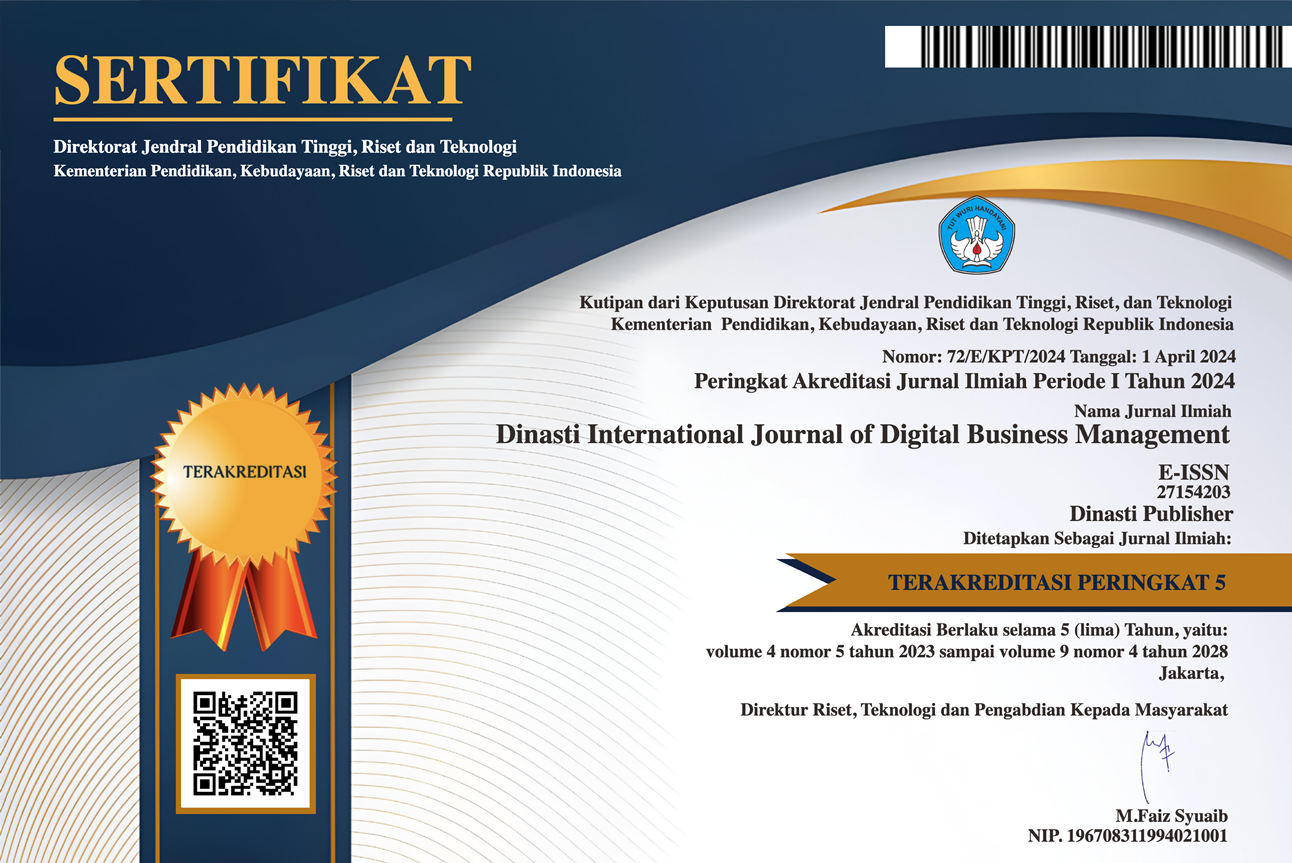Negative Marketing in The Softdrink Industry: The Effect of Greenwashing Perceptions on Purchase Intention Through Brand Image on Sprite
DOI:
https://doi.org/10.38035/dijdbm.v5i5.2824Keywords:
Greenwashing, Greenwashing Perceptions, Brand Image, Purchase IntentionAbstract
This study examines the impact of greenwashing perceptions on consumer purchase intention for eco-friendly soft drinks in Jakarta, with brand image as a moderating variable. Although the public is increasingly aware of the importance of eco-friendly products, corporate marketing practices have not supported this trend. Using descriptive and quantitative methods, with 73 respondents selected through purposive sampling and analyzed using SmartPLS 3.2.9, the results show that greenwashing perceptions affects brand image but does not influence purchase intention. Brand image also does not affect purchase intention or mediate the relationship between greenwashing and purchase intention. In conclusion, transparency and sustainability are crucial to avoiding greenwashing and enhancing brand image and consumer purchase intention.
References
Bagozzi, R. R., & Yi, Y. (2018). On the Evaluation of Structural Equation Models.
Brouwer, A. (2016). REVEALING GREENWASHING: A CONSUMERS’ PERSPECTIVE.
Bruhn, M., Schnebelen, S., & Schäfer, D. (2014). Antecedents and consequences of the quality of e-customer-to-customer interactions in B2B brand communities. Industrial Marketing Management, 43(1), 164–176. https://doi.org/10.1016/j.indmarman.2013.08.008
Dong, Y. (2016). Whom Your Brand Is More Like? Analysis of Brand Image and Brand Personality.
Fiore, D. (2008). CHAPTER 11 Body Painting and Visual Practice: The Creation of Social Identities through Image Making and Display in Tierra del Fuego (Southern South America).
Francis, C., Elmore, R., Ikerd, J., & Duffy, M. (2007). Greening of agriculture: Is it all a greenwash of the globalized economy? In Journal of Crop Improvement (Vol. 19, Issues 1–2, pp. 193–220). https://doi.org/10.1300/J411v19n01_10
Haenlein, M., & Kaplan, A. M. (2004). A Beginner’s Guide to Partial Least Squares Analysis. Understanding Statistics, 3(4), 283–297. https://doi.org/10.1207/s15328031us0304_4
Haryanto, P. C., & Arty, I. S. (2019). The Application of Contextual Teaching and Learning in Natural Science to Improve Student’s HOTS and Self-efficacy. Journal of Physics: Conference Series, 1233(1). https://doi.org/10.1088/1742-6596/1233/1/012106
Leone, R. P., Rao, V. R., Keller, K. L., Luo, A. M., McAlister, L., & Srivastava, R. (2006). Linking brand equity to customer equity. In Journal of Service Research (Vol. 9, Issue 2, pp. 125–138). https://doi.org/10.1177/1094670506293563
Malmelin, N., & Moisander, J. (2014). Brands and Branding in Media Management-Toward a Research Agenda. JMM International Journal on Media Management, 16(1), 9–25. https://doi.org/10.1080/14241277.2014.898149
Malyan & Duhan, 2018. (2018). GREEN CONSUMERISM Perspectives, Sustainability, and Behavior.
Muhammad Akram Khan, T. W. (2003). Islamic Economics and Finance: A Glossary (2nd ed.).
Niessen, & Hamm, &. (2008). Identifying the gap between stated and actual buying behaviour on organic products based on consumer panel data. http://orgprints.org/11998
Novita, & Rowena, J. (2019). Determinant factors of Indonesian people’s fish purchase intention. British Food Journal, 123(6), 2272–2277. https://doi.org/10.1108/BFJ-01-2019-0067
Nyilasy, G., Gangadharbatla, H., & Paladino, A. (2014). Perceived Greenwashing: The Interactive Effects of Green Advertising and Corporate Environmental Performance on Consumer Reactions. Journal of Business Ethics, 125(4), 693–707. https://doi.org/10.1007/s10551-013-1944-3
Polonsky, M. J. (2011). Transformative green marketing: Impediments and opportunities. Journal of Business Research, 64(12), 1311–1319. https://doi.org/10.1016/j.jbusres.2011.01.016
Riyanto, R. R., Sander, O. A., Megawati, Y., Elim, R. A. K., & Cerlysia, C. (2023). THE IMPACT OF LEMONILO GREEN MARKETING ON PURCHASE INTENTION. International Journal of Application on Economics and Business, 1(3), 1581–1589. https://doi.org/10.24912/ijaeb.v1i3.1581-1589
Schmuck, D., Matthes, J., Naderer, B., & Beaufort, M. (2018). The Effects of Environmental Brand Attributes and Nature Imagery in Green Advertising. Environmental Communication, 12(3), 414–429. https://doi.org/10.1080/17524032.2017.1308401
Singhal, A., & Malik, G. (2018). The attitude and purchasing of female consumers towards green marketing related to cosmetic industry. Journal of Science and Technology Policy Management, 12(3), 514–531. https://doi.org/10.1108/JSTPM-11-2017-0063
Utami. (2022). Negative Marketing in The Cosmetics Industry: The Effect of Greenwashing Perceptions on Purchase Intention through Brand Image. Universitas Brawijaya. DOI: Journal of Applied Management (JAM), 20(3), 721–737. https://doi.org/10.21776/ub.jam
Wahyudi. (2019). Pelaksanaan Model Kooperatif Tipe Structured Numbered Heads Dalam Pembelajaran Matematika Di Kelas X Akuntansi 3 SMKN 2 Padang.
Wijaya, J. A., & Susilawaty, L. (2023). PENGARUH FITUR IKLAN MEDIA SOSIAL TERHADAP NIAT BELI YANG DIMEDIASI OLEH KETERLIBATAN MEREK PADA LAPTOP LENOVO THE EFFECT OF SOCIAL MEDIA ADVERTISING FEATURES ON PURCHASE INTENTION MEDIATED BY BRAND ENGAGEMENT ON LENOVO LAPTOPS. Business Management Journal, 19(2), 143–161. https://doi.org/10.30813/bmj.v19i2.4654
Zhang, Y. (2015). The Impact of Brand Image on Consumer Behavior: A Literature Review. Open Journal of Business and Management, 03(01), 58–62. https://doi.org/10.4236/ojbm.2015.31006
Downloads
Published
Issue
Section
License
Copyright (c) 2024 Eric Chandra, Novita Novita

This work is licensed under a Creative Commons Attribution 4.0 International License.
Authors who publish their manuscripts in this journal agree to the following conditions:
- The copyright on each article belongs to the author(s).
- The author acknowledges that the Dinasti International Journal of Digital Business Management (DIJDBM) has the right to be the first to publish with a Creative Commons Attribution 4.0 International license (Attribution 4.0 International (CC BY 4.0).
- Authors can submit articles separately, arrange for the non-exclusive distribution of manuscripts that have been published in this journal into other versions (e.g., sent to the author's institutional repository, publication into books, etc.), by acknowledging that the manuscript has been published for the first time in the Dinasti International Journal of Digital Business Management (DIJDBM).















































